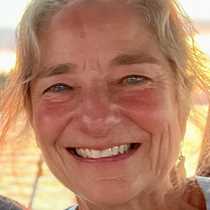Bahia Magdalena, Hull Canal, Boca de Soledad
Last night the ship sat securely at anchor off the town of San Carlos in Bahia Magdalena. Brisk winds greeted us as we awoke this morning, our first day among the great whales of Baja California.
As we transited to the northern end of Bahia Magdalena, our long-trusted pilot, Alejandro, expertly guided the ship north through the narrow and very shallow Hull Canal. Our vessel is by far the largest to transit this mangrove-lined channel, and Alejandro knows this channel well, having placed his own home-made channel markers. While he was at the helm following the channel, we were on the bow, watching for birds on mangroves, and on mudflats nearby. There were so many birds! We saw great blue herons, yellow-crowned night herons, green herons, reddish egrets, white ibises, frigatebirds . . . the list goes on and on. Many of the double-crested cormorants had nuptial plumes, a pair of small tufts of white feathers on top of the head, visible for a short time during breeding season.
Late in the morning, Larry Hobbs gave an illustrated presentation about gray whales, which he peppered with interesting anecdotes from his 35 years’ experience studying and observing these animals here in Baja California.
As we ate lunch, the ship anchored near Boca de Soledad, the ‘Mouth of Solitude,’ which is Magdalena Bay’s northern opening to the Pacific Ocean. From the ship’s protected location, we could look at the entrance and see waves crashing over the numerous sand bars that make this mouth so dangerous for larger ships such as our own. After giving birth in more protected waters further inside the bay, mother grays bring their calves here, where strong currents provide a place for calves to strengthen their swimming before leaving for the northward migration. When the calves are about 3 months old, they swim more than 5,000 miles alongside their mothers to Arctic feeding grounds, a remarkable feat!
We spent the afternoon cruising in Zodiacs, hoping to get closer looks at gray whale mothers and calves . . . and we found them! As the calves surfaced, they were easy to distinguish, not only due to their ‘small’ size (can 18 feet really be considered small??), but because their skin was so much darker and smoother than mom’s skin. Often, as a mother surfaced, her calf could be seen rolling off her back; when they are young, they frequently swim atop their mothers. At times, whales approached the Zodiacs, and we then had to protect our faces and cameras from their blows as well as spray from splashing waves. At other times, we got very close looks as they surfaced within arm’s reach of the boats.
Last night the ship sat securely at anchor off the town of San Carlos in Bahia Magdalena. Brisk winds greeted us as we awoke this morning, our first day among the great whales of Baja California.
As we transited to the northern end of Bahia Magdalena, our long-trusted pilot, Alejandro, expertly guided the ship north through the narrow and very shallow Hull Canal. Our vessel is by far the largest to transit this mangrove-lined channel, and Alejandro knows this channel well, having placed his own home-made channel markers. While he was at the helm following the channel, we were on the bow, watching for birds on mangroves, and on mudflats nearby. There were so many birds! We saw great blue herons, yellow-crowned night herons, green herons, reddish egrets, white ibises, frigatebirds . . . the list goes on and on. Many of the double-crested cormorants had nuptial plumes, a pair of small tufts of white feathers on top of the head, visible for a short time during breeding season.
Late in the morning, Larry Hobbs gave an illustrated presentation about gray whales, which he peppered with interesting anecdotes from his 35 years’ experience studying and observing these animals here in Baja California.
As we ate lunch, the ship anchored near Boca de Soledad, the ‘Mouth of Solitude,’ which is Magdalena Bay’s northern opening to the Pacific Ocean. From the ship’s protected location, we could look at the entrance and see waves crashing over the numerous sand bars that make this mouth so dangerous for larger ships such as our own. After giving birth in more protected waters further inside the bay, mother grays bring their calves here, where strong currents provide a place for calves to strengthen their swimming before leaving for the northward migration. When the calves are about 3 months old, they swim more than 5,000 miles alongside their mothers to Arctic feeding grounds, a remarkable feat!
We spent the afternoon cruising in Zodiacs, hoping to get closer looks at gray whale mothers and calves . . . and we found them! As the calves surfaced, they were easy to distinguish, not only due to their ‘small’ size (can 18 feet really be considered small??), but because their skin was so much darker and smoother than mom’s skin. Often, as a mother surfaced, her calf could be seen rolling off her back; when they are young, they frequently swim atop their mothers. At times, whales approached the Zodiacs, and we then had to protect our faces and cameras from their blows as well as spray from splashing waves. At other times, we got very close looks as they surfaced within arm’s reach of the boats.



